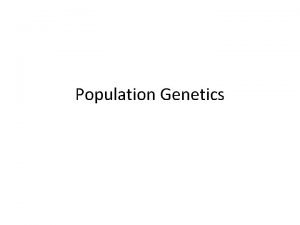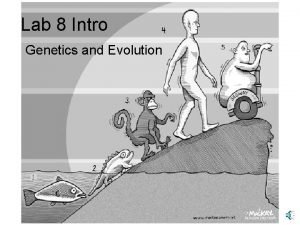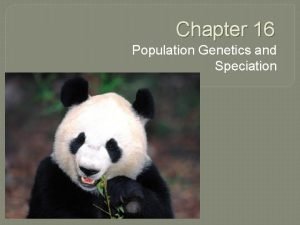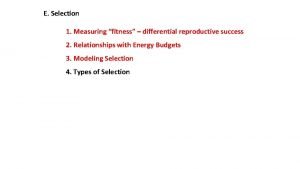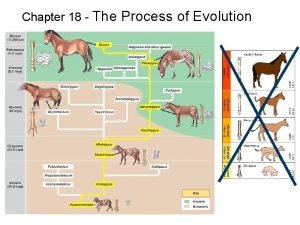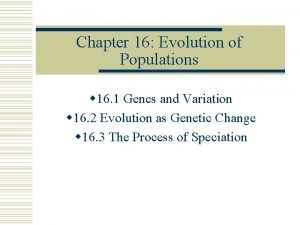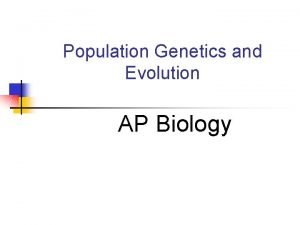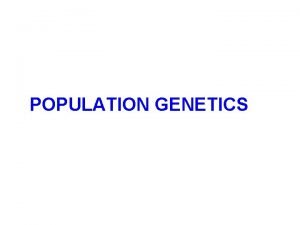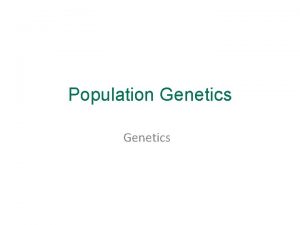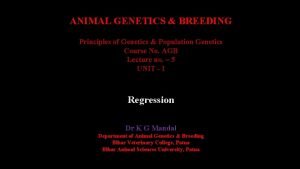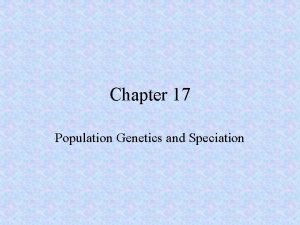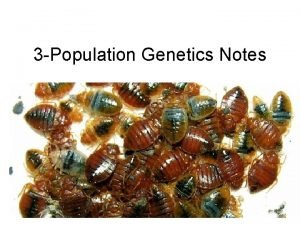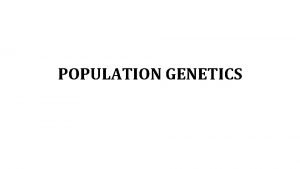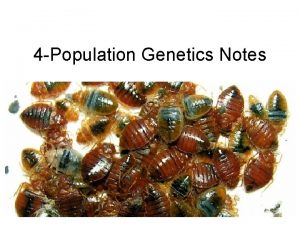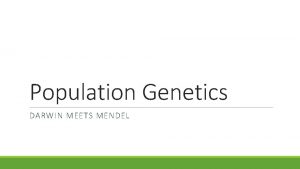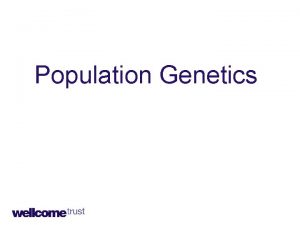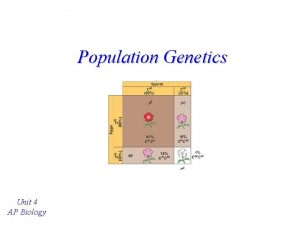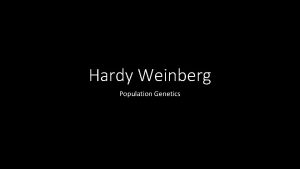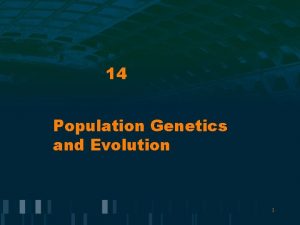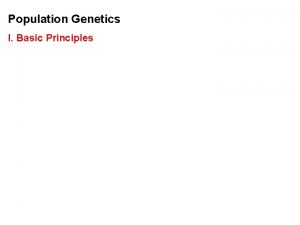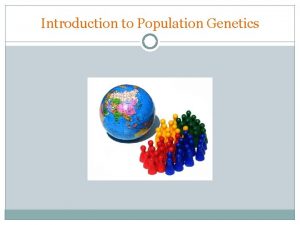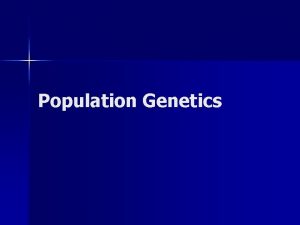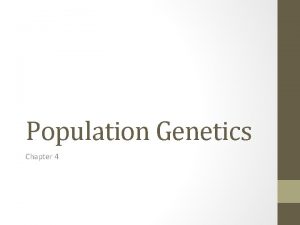Why have sex The population genetics of sex




















- Slides: 20

Why have sex? The population genetics of sex and recombination Sally Otto Department of Zoology University of British Columbia

INTRODUCTION Asexuals: Sexuals: The unit of reproduction is the individual The unit of reproduction is the couple Unless the sexual couple produces twice as many offspring as the asexual individual, there will be a cost of sex. The "sexual female propagates her genome, or any given element of her genome, only half as efficiently as the asexual female" — Bell 1982

Other costs of sex: • • • Cost of finding a mate Risk of not finding a mate Risk of disease transmission during mating Loss of heterozygosity Destruction of favorable gene combinations Despite these costs of sex, the vast majority of eukaryotic organisms are sexual è The paradox of sex

What might offset the cost of sex? • Paternal contribution to the production and rearing of offspring What might pay the cost of sex? • Most explanations of sex stem from the idea that sex can generate greater variability through chromosomal segregation and recombination.

But sex does not always diversify an offspring population: Genetic Variance in Fitness Without sex AB ab Ab a. B ab AB Ab or a. B With sex WAB = 1 WAb = 0. 9 Wa. B = 0. 9 Wab = 0. 81 0. 0060 0. 0045

An increase in genetic variation (Vg) generally improves the response of a population to selection. • Identify the conditions under which sex and recombination increase genetic variation • Determine the extent to which this force favors the evolution of sex and recombination

Genotypes that are more common than expected based on Hardy-Weinberg or linkage equilibrium are typically more common because they have been favored by selection. By destroying these genetic associations, sex and recombination typically reduce the average fitness of offspring. è RECOMBINATION LOAD

Determining when sex and recombination are favored is essentially a search for the conditions where: • Genetic variation in fitness is increased by sex and recombination • Recombination load is weak or reversed Recombination load D Vg

Three-locus Model M Genotype at a modifier locus determines the probability of recombination: Genotype at selected loci determines fitness: A RMM RMm Rmm B r. MM r. Mm rmm Wij i, j = 1 for AB = 2 for Ab = 3 for a. B = 4 for ab

ASIDE: Are sex and recombination interchangeable? ? ? In general, NO, because sex involves both segregation and recombination. è Segregation at one locus can exert selection for/against sex (Kirkpatrick and Jenkins 1989; Chasnov 2000; Agrawal 2001*) In haploid models, however, the probability of sex and the probability of recombination enter into models as their product. (True also for special diploid models where HW is maintained by selection. ) è Models that examine the fate of alleles that modify recombination rates inform us about the fate of alleles that modify the probability of engaging in sex.

Directional selection • • • Spread of a beneficial mutation Mutation-selection balance Fluctuating selection (with a long period) 1. 75 Beneficial 1. 5 Positive epistasis Multiplicative Negative epistasis 1. 25 Haploid Fitness 1 0. 75 Positive epistasis Multiplicative Negative epistasis ] 0. 5 Deleterious 0. 25 0 1 2 Number of mutations Haploid Fitness: 1 1+s (1+s)2+e

Initial Population 0. 4 D=0 0. 3 0. 2 0. 1 AB Ab e<0 ab e=0 D<0 0. 4 a. B D=0 0. 4 e>0 0. 3 0. 2 0. 1 AB Ab a. B ab AB Ab a. B D>0 0. 4 ab AB Ab a. B ab

Directional selection 30 20 Rec load = D Vg = Decreased recombination 10 0. 1 0 0. 2 0. 3 0. 4 Increased recombination 0. 5 Rec -10 -20 Decreased recombination -30 (Barton 1995; Otto and Feldman 1997) Rec load = D Vg =

30 20 Implications 10 0 -10 Decreased recombination 0. 1 0. 2 0. 3 Increased recombination -20 -30 Decreased recombination Sex/recombination may evolve when: • • • 0. 4 Epistasis is negative Epistasis is weak or linkage tight Variance in epistasis is low Broader conditions favor the evolution of a bit of sex/rec than frequent sex/rec. 0. 5 Rec

Less restrictive explanations? ? ? Temporal variation in selection (e. g. host-parasite mediated): • Disequilibrium may reflect past not current selection è Sex/recombination can gain an immediate fitness benefit by breaking down disequilibrium • Rec load = But fluctuations have to be very rapid (2~5 generations) (Barton 1995; Peters and Lively 1999)

Spatial variation in selection: • Disequilibrium may reflect distant not local selection è Sex/recombination can gain an immediate fitness benefit by breaking down disequilibrium Rec load = è High rates of sex/recombination may evolve when s. A s. B Cov(s. A, s. B) > 0 & e << 0 deme 1 deme 2 / s. B s. A deme 1 deme 2 (Pylkov et al 1998; Lenormand Otto 2000) Cov(s. A, s. B) < 0 & e>0

Disequilibrium generated by genetic drift: • Disequilibrium may be generated by the chance background on which mutations appear or random drift in finite populations. Drift by itself does not bias D • When D > 0 (Vg ), selection acts more rapidly and D dissipates. • When D < 0 (Vg ), selection acts less rapidly and D remains. è Drift with selection generates, on average, negative disequilibrium that reduce the response to selection è Selection for increased sex/rec, especially when there is strong selection, a small population size, and low initial sex/rec. (Otto and Barton 1997, 2001; Barton and Otto 2002)

Comparing the force of drift and epistasis: è Proportional change in sex/rec over 50 generations with very strong selective sweeps (1+s = 2) 4 3 % change in sex/rec 2 Initial favorable allele frequency = 0. 01 rmm = 0. 1 r. Mm = 0. 15 r. MM = 0. 2 / e = -1. 21 e = -1 1 50 -1 100 500 100000 Population size (2 N) (Otto and Barton 2001) e = -0. 2 =0 ∞ e e=1

3 Implications 2 / 1 50 -1 100 500 100000 Population size (2 N) Small populations: Effect of epistasis < effect of drift Large populations: Effect of epistasis > effect of drift è Effect due to drift alone can be larger than the best case scenario with epistasis alone ∞

Conclusions Conditions favoring the evolution of sex and recombination are surprisingly persnickety è DATA. . . epistasis, variance in epistasis, strength of selection, form of species interactions, form of spatial variation, frequency of beneficial sweeps. . .
 Sex sex sex
Sex sex sex Greenhouse sex
Greenhouse sex Xxtesticles
Xxtesticles Sex sex sex
Sex sex sex Secondary sexual characters
Secondary sexual characters Hey bye bye
Hey bye bye Genetics
Genetics Similar
Similar Population genetics and speciation worksheet answer key
Population genetics and speciation worksheet answer key Population genetics
Population genetics The far side comics
The far side comics Population genetics
Population genetics Genetics
Genetics Chapter 4 section 1 population dynamics answer key
Chapter 4 section 1 population dynamics answer key Section 1 population dynamics
Section 1 population dynamics Population ecology section 1 population dynamics
Population ecology section 1 population dynamics Chapter 4 population dynamics study guide answers
Chapter 4 population dynamics study guide answers Punnett square for sex linked traits
Punnett square for sex linked traits Sex determination in drosophilla
Sex determination in drosophilla Sex determination and sex linkage
Sex determination and sex linkage Once a sex offender always a sex offender
Once a sex offender always a sex offender






